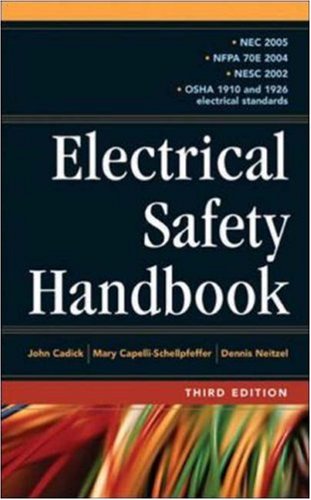

Most ebook files are in PDF format, so you can easily read them using various software such as Foxit Reader or directly on the Google Chrome browser.
Some ebook files are released by publishers in other formats such as .awz, .mobi, .epub, .fb2, etc. You may need to install specific software to read these formats on mobile/PC, such as Calibre.
Please read the tutorial at this link. https://ebooknice.com/page/post?id=faq
We offer FREE conversion to the popular formats you request; however, this may take some time. Therefore, right after payment, please email us, and we will try to provide the service as quickly as possible.
For some exceptional file formats or broken links (if any), please refrain from opening any disputes. Instead, email us first, and we will try to assist within a maximum of 6 hours.
EbookNice Team

Status:
Available4.7
37 reviews
ISBN 10: 0071457720
ISBN 13: 9780071457729
Author: John Cadick, Mary Capelli Schellpfeffer, Dennis Neitzel
This is an accident-avoiding prescription for electricians, safety managers, and inspectors, and engineers dealing with electricity any voltage level. Presenting crucial protective safety strategies for industrial and commercial systems, the Handbook references all major safety codes (OSHA, NEC, NESC, and NFPA) where appropriate, creating a unique, one-stop compliance manual for any company’s electrical safety training and reference needs.
Chapter 1. Hazards of Electricity
Introduction
Glossary
Hazard Analysis
Shock
Description
Influencing Factors
Arc
Definition and Description
Arc Energy Release
Arc Energy
Arc Energy Input
Arcing Voltage
Arc Surface Area
Incident Energy
Arc Burns
Blast
Affected Body Parts
General
Skin
The Nervous System
Muscular System
The Heart
The Pulmonary System
Summary of Causes—Injury and Death
Shock Effect
Arc Flash Effect
Causes of Injury
Causes of Death
Protective Strategies
References
Chapter 2. Electrical Safety Equipment
Introduction
Glossary
General Inspection and Testing Requirements for Electrical Safety Equipment
Flash and Thermal Protection
A Note on When to Use Thermal Protective Clothing
Thermal Performance Evaluation
Clothing Materials
Non-Flame-Resistant Materials
Flame-Resistant Materials
Work Clothing
Flash Suits
Head, Eye, and Hand Protection
Head and Eye Protection
Hard Hats
Safety Glasses, Goggles, and Face Shields
Rubber-Insulating Equipment
Rubber Gloves
Rubber Mats
Rubber Blankets
Rubber Covers
Line Hose
Rubber Sleeves
In-Service Inspection and Periodic Testing of Rubber Goods
Hot Sticks
Description and Application
When to Use
How to Use
Testing Requirements
Insulated Tools
Description and Application
When to Use
How to Use
Barriers and Signs
Barrier Tape
Signs
When and How to Use
Safety Tags, Locks, and Locking Devices
Safety Tags
Locks and Multiple-Lock Devices
Locking Devices
When/Where to Use Lockout Tagout
Voltage-Measuring Instruments
Safety Voltage Measurement
Proximity Testers
Contact Testers
Selecting Voltage-Measuring Instruments
Instrument Condition
Low Voltage Voltmeter Safety Standards
Three-Step Voltage Measurement Process
General Considerations for Low-Voltage Measuring Instruments
Safety Grounding Equipment
The Need for Safety Grounding
Safety Grounding Switches
Safety Grounding Jumpers
Selecting Safety Grounding Jumpers
Installation and Location
Ground Fault Circuit Interrupters
Operating Principles
Applications
Safety Electrical One-Line Diagram
The Electrician’s Safety Kit
References
electrical safety handbook 5th edition
electrical safety books pdf
pe electrical handbook
electrical safety rob zachariason
electrical safety book
electrical safety handbook
Tags: John Cadick, Mary Capelli Schellpfeffer, Dennis Neitzel, Electrical, Safety